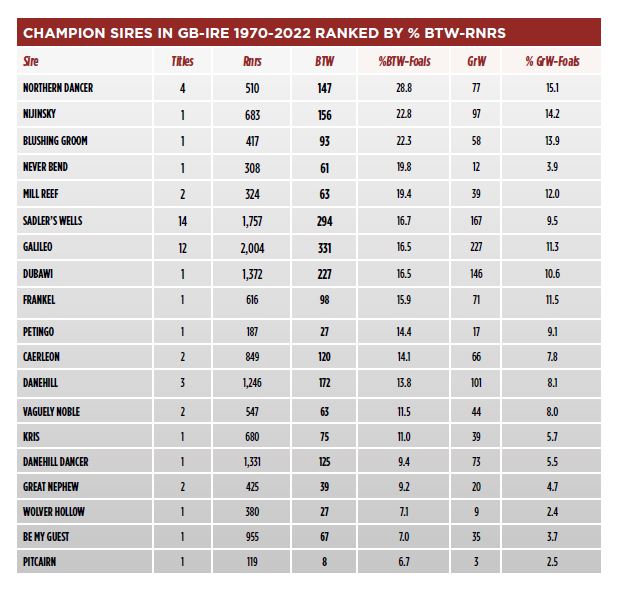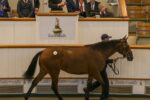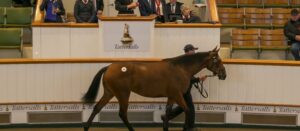Since 1970 there have been 53 Britain and Ireland champion sire’s titles bestowed on 20 individual stallions, the latest being Darley’s Dubawi, who had to wait until he was 20-years-old to receive the accolade, such was the dominance of Coolmore’s great 12-time champion Galileo. And when Galileo did eventually vacate his throne, his son Frankel nipped in for his first title in 2021, thus prolonging Dubawi’s wait by another year.
It just goes to show that all statistics need some sort of qualification or other. Dubawi is clearly a once-in-a-lifetime sire and a single champion title hardly seems to do him justice. This point is underlined even more when we look back at the champion sires since 1970. The first thing to note is that gone are the days when a stallion could steal a title by siring just one, or maybe two, dominant runners. Queen’s Hussar’s success in 1972 was all because of the great Brigadier Gerard, one of only five stakes winners accredited to Queen’s Hussar from a total of 290 career runners, although he was later also responsible for the 1,000 Guineas and French Oaks heroine Highclere, who has done much more to preserve her sire’s name in top-flight pedigrees than the Brigadier.
Another sire who relied on one or two good ones was Pitcairn, the champion sire of 1980. That year, the son of the previous year’s champion Petingo was responsible for Ela-Mana- Mou, who flourished after joining the Major Dick Hern stable as a four-year-old to land the Eclipse Stakes and King George. He was ably assisted by the very high-class Irish-trained Cairn Rouge, who took that year’s Irish 1,000 Guineas, Coronation Stakes and Champion Stakes.
Remarkably, the 132-rated Ela-Mana-Mou and Cairn Rouge (127) were two of Pitcairn’s sum total of three career Group winners. What are the odds of finding two standout runners from such a small pool and both in the same year, too?
Wolver Hollow, the Eclipse Stakes winner who got Sir Henry Cecil’s training career off to a fine start in 1969, is another who relied almost entirely on a single runner to win his title in 1976. That horse was Wollow, who annexed the 2,000 Guineas, Eclipse Stakes, Sussex Stakes and Benson & Hedges Gold Cup (now known as the Juddmonte International), having also won the previous season’s Dewhurst Stakes. Wolver Hollow sired a total of just nine career Group winners and only two others, the Irish 2,000 Guineas winner Furry Glen, who later plied his trade as a National Hunt sire, and Galaxy Libra, a dual Grade 1 winner on turf in America, won at the highest level.
Other than Queen’s Hussar, Pitcairn and Wolver Hollow, the remaining 17 champions bear closer scrutiny. The master of all has to be Northern Dancer who won four titles, commencing in 1970 when Nijinsky swept all before him in his Triple Crown year. While it is true that he is far short of his son Sadler’s Wells’s tally of 14 titles and his grandson Galileo’s 12, for sheer quality there has never been a sire in these parts to match him.
Moreover, his influence on the champion sires that came after him has been profound to say the least. Of the 53 titles since 1970, Northern Dancer has either won or been responsible for the winner through his male line on no fewer that 39 occasions. And 40, if you give him a little bit of credit for turning up twice in the pedigree of Dubawi, albeit in the fourth and fifth generations.
More importantly, for all their far superior numerical advantages, neither Sadler’s Wells nor Galileo have sired a better top ten racehorses than their fore-bearer, at least according to Timeform. Northern Dancer’s top ten are: Nijinsky (138), El Gran Senor (136), The Minstrel (135), Shareef Dancer (135), Storm Bird (134), Lyphard (132), Sadler’s Wells (132), Nureyev (131), Unfuwain (131), Try My Best (130) and Ajdal (130). His ratio of stakes winners to runners at 28.8% – at the top of our list – also suggests as much.

A word of caution here in that small elite books of mares will always contain a higher percentage of stakes winners than the books with the same number of elite mares but with a hundred or so more extra mares with poorer credentials. Hence, the modern-day standard of about 16% serves to identify a top-class stallion like a Galileo, a Frankel or a Dubawi.
Interestingly, the first four stallions on our list were all based in America. That’s another thing that is very unlikely ever to happen again, due to the number of high-class runners required these days to win a title. Perhaps the best champion sire in these islands before the Northern Dancer clan was Mill Reef, who sired 324 runners from just 13 crops and was the last champion sire based in Britain before Frankel and Dubawi came along. His 19.8% stakes winners is exceptional in its own right, but to provide some context here, it is worth knowing that Galileo scores 20.4% from the 1,174 runners from his elite mares and could do even better if we scaled his numbers back to the best-bred 350 or so. Still, runners like Reference Point, Shirley Heights, Milligram, Acamas serve to illustrate what a fine stallion Mill Reef was.
Great Nephew was champion sire on two occasions, the first in 1975 being thanks to the brilliant Grundy, winner of the Derby, King George, Irish Derby and Irish 2,000 Guineas, and the second in 1981 to the even more brilliant Shergar, another dual Derby and King George winner. Meanwhile, Kris, won his sole title after a battle with Shirley Heights in 1985. That year, Shirley Heights provided the Derby winner in Slip Anchor, but his earnings were eclipsed by those of Oh So Sharp, who gained notoriety for winning the 1,000 Guineas, Oaks and St Leger.
Petingo, a top-class winner of the Sussex Stakes, had the impressive Derby winner Troy to thank for his 1979 title of champion sire. Troy’s other victories in the Irish Derby, King George and Benson & Hedges Gold Cup ensured his sire was well clear of the opposition. Petingo succumbed to a heart attack during the 1976 covering season and left only seven full crops that also featured the dual Oaks heroine Fair Salinia and Irish Derby winner English Prince.
In 1982, the first of Coolmore’s titles came with Be My Guest, the Northern Dancer sire who provided two of the best racehorses that year from his first crop in the shape of Assert and On The House.
Six years on, Coolmore’s Caerleon was champion and repeated the feat in 1991, thanks to Derby and King George winner Generous. Following Sadler’s Wells first crown in 1990, you would have got long odds about Coolmore stallions reigning supreme for the next 30 years. But that is precisely what happened, with Danehill and his son Danehill Dancer essentially bridging the gap between the Sadler’s Wells and Galileo dynasties. For the record, only Highflyer with his 13 titles between 1785 and 1798 has come close to the two Coolmore giants.



